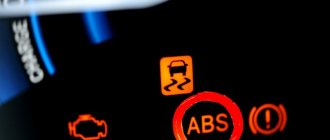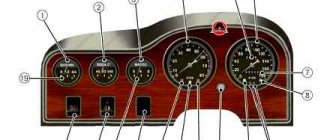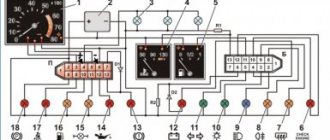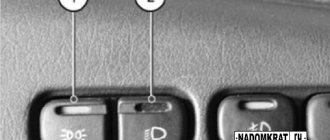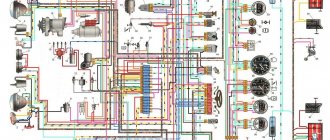Modern cars are equipped with electronic assistants. One of them is the ABS system. If the ABS light on the dashboard is on, it means there is a malfunction in one of the elements of this system. It will not work; during emergency braking, your car's wheels will lock. This is fraught with the risk of the car getting into a skid; it will not be possible to go around an obstacle with locked wheels - an accident. Therefore, the functionality of this system is important for your safety.
Let's look at the reasons why the ABS light is on and what an ordinary car owner can check on his own, without resorting to the help of car services and special equipment. But the problem may be trivial, which can be solved in your garage.
Reasons for ABS system failure and what to do
Water getting into the contacts of the ABS control unit
We find the system control unit under the hood. It usually looks like a rectangular iron box with several metal tubes. There may be five or four of them. This is the anti-lock braking system unit. The power and control connector is connected to it - a large plug, it only fits the case, you won’t get it mixed up.
Disconnect the negative terminal of the battery and disconnect this connector from the ABS control unit. We check its contacts for moisture or mechanical damage. There were cases when they rotted and were destroyed by age and water, despite the moisture-proof casing of the connector. It may be damaged, allowing water to penetrate inside.
If you find moisture inside, blow and dry the plug and contacts both on it and on the control unit. If there is visible damage to the contacts of the plug, only replace it; if there is visible damage to the contacts of the ABS computer, then contact specialists who can replace the connector.
Fuse box
This is the simplest thing that a simple driver can check on his own if the ABS light comes on. It is advisable to check them first - this is the easiest way. We wipe our hands and climb under the hood, looking for a mounting block - a plastic box with fuses and relays.
Open it and turn over the top cover. It usually says where and what fuses are located in the block. We find the inscription “ABS” and according to the diagram we look for the fuse that is responsible for this system.
Checking the fuse. Usually there should be spare fuses in the mounting block if the machine is completely new. If there are none, then you can use the adjacent fuse. For example, remove a fan, horn, or other less important systems that were definitely working from the power socket. And insert in place of the old ABS fuse.
Mud and snow
Further verification becomes a little more complicated. The sensors are located on the wheel hubs. Snow or dirt may stick between them and the gear, also called the ABS ring. They stop reading the rotation speed, and the ABS error light comes on.
The anti-lock braking system (ABS) is designed to maintain vehicle control and stability when the brakes are applied suddenly. In most cases, it is an invaluable assistant to the driver, preventing the risk of getting into an accident. However, the benefits of ABS appear on smooth surfaces, but in snowfall, on an icy road surface or uneven surfaces, it can be harmful, increasing the braking distance. Therefore, some drivers seek to disable ABS completely or temporarily.
Typically, the manufacturer does not provide for disabling ABS, although on some models, especially sports ones, this function is present. Therefore, drivers have to resort to tricks and disconnect the power circuit to turn off the system.
What can you check yourself if the ABS light comes on?
The first thing you can do on your own in such a situation is to go to a car wash and ask for a good wash of the rims. Often, this intensive pressure washing can clean the ABS sensors located near the brake discs. On your way to the car wash, you can perform another simple test. Accelerate to a speed of 80-90 kilometers per hour, close the windows and turn off the music. If in this driving mode you hear a slight or annoying hum in the area of the wheels (front or rear), the likely cause of the light is a failure of the wheel bearing. There are several other things you can do:
- inspect the fuse box and replace the module that is responsible for the operation of the anti-lock braking system;
- if possible, read the diagnostic error code and read about it on the forums;
- to a specialist, describing your situation, and then try to correct the error yourself;
- get to the ABS sensors yourself by jacking up the car and removing the wheels to check their cleanliness;
- inspect the electronic control unit located under the hood, check that there is no liquid in it or on it;
- the best solution is to go to a service station and pay for diagnostics of the car's anti-lock braking and electrical systems.
Why might you need to disconnect?
Most drivers turn off ABS in conditions where it could do more harm than good: on snowy or sandy surfaces, on icy roads, or when the road surface is covered with holes and potholes. In such conditions, ABS operation increases the braking distance, which can lead to dangerous situations.
Also, disabling ABS may be necessary when its sensors or control unit are not working correctly, which leads to incorrect operation of ABS and threatens emergency situations.
Another reason for disabling the anti-lock braking system is the driver’s desire to use a sporty driving style with controlled drifts and wheel locking.
ABS does not allow you to practice controlled skidding of the car, so you have to turn off the system.
ESC and TC function
After starting the engine, ESC and TC are switched on automatically.
To turn off ESC and TC when driving in difficult road conditions (mud, sand, deep snow), press and hold the “ESC” switch button pressed for 0.5–1 seconds. Disabling functions only works when the vehicle speed is less than 50 km/h. The functions are activated by briefly pressing the “ESC” switch button or automatically when the speed reaches 50 km/h.
The operation of ESC and TC is accompanied by a characteristic noise of the actuators. The activation of ESC and TC indicates that the limit of tire adhesion to the road surface has been reached. To avoid losing control of the vehicle, you must adapt your driving style to the actual road conditions.
The ESC and TC status are indicated by the “ESC” and “ESC OFF” indicators. The warning lights light up yellow when the ignition is turned on and go out after the engine starts (self-test mode). Triggering of ESC and TC is accompanied by flashing of the “ESC” indicator. When the functions are disabled using the “ESC” switch, the “ESC OFF” indicator lights up with a constant light.
Attention ! In all other cases, the lighting of the “ESC” indicator indicates a malfunction of the ESC and TC, which must be repaired only by dealers.
Attention ! To avoid limiting the performance of ABS, EBD, ESC and TC, do not install tires of different sizes on the vehicle.
How the vehicle's stability control system works is also shown in the video:
Is it possible to turn it off without consequences?
The main thing that threatens a driver who has de-energized the anti-lock braking system is an increased risk of getting into an accident. Therefore, disabling ABS in constant mode or when driving in urban conditions is not permissible. This may be a temporary measure in difficult driving conditions and cannot be used permanently due to the increased likelihood of being involved in an accident.
It must be taken into account that a modern car is a high-tech product, so interfering with its structure can lead to negative consequences. Many manufacturers additionally insure against those wishing to disable the ABS. For example, on Renault cars, de-energizing the ABS will lead to failure of the speedometer, odometer and fuel consumption sensor.
Another disadvantage of unauthorized disabling of ABS is a possible refusal at the service station to provide warranty repairs or maintenance of the vehicle.
The on-board computer “remembers” unauthorized intervention in the operation of the system, so if the ABS is disabled, warranty service employees will definitely have questions for the driver.
Manufacturer's shutdown
If there is a button to disable ABS on the car’s instrument panel, then the on-board computer’s memory will not record interference in the car’s design. So the driver will not face consequences in the form of refusal of warranty repairs or service.
However, in other respects, turning off ABS from the button is no different from an emergency de-energization of the system. In this case, the driver must understand the consequences of driving a car without an anti-lock braking system.
Some automakers provide optional ABS disabling
Looking for a reason
You should start troubleshooting with the fuse. If this element burns out, the ABS does not work. Note that you should not always go into the fuse box, since the behavior of the system itself can give a “hint” regarding the serviceability of the fuse. For example, if the ABS light on the instrument panel comes on only under certain conditions, but after turning off the power to the ignition switch and restarting the engine, the problem disappears, then the problem is clearly not in the fuse. It should only be checked if the warning light is constantly on.
The sensors are located in a place that cannot be called well protected. Therefore, dirt sticking to it will easily cause a malfunction, causing the system to shut down.
Sensors may simply break during the process of repairing and servicing the chassis. Careless work and the use of impact tools during disassembly often cause internal damage to the sensors. Since they cannot be repaired, the damaged element will have to be replaced to restore ABS functionality.
How to disable ABS
The shutdown provided by the manufacturer will only require pressing a button on the car’s dashboard.
If such a function is not provided, you will need to de-energize the ABS.
What you need
To de-energize the anti-lock braking system, you must gain access to the fuse box. In order to get rid of the ABS error light, you will need a five-pin relay, which can be purchased at any radio store or auto store.
Step by Step Actions
The sequence of actions when de-energizing the ABS system is as follows.
- You need to open the fuse box located in the passenger compartment under the steering column or engine compartment next to the battery. You can find out exactly where the ABS fuse is located in your vehicle's owner's manual.
- You need to disconnect the fuse terminals and remove it from the socket. After this, the anti-lock braking system will be de-energized.
The result of this operation is the activation of the ABS error light, and an audible error warning is also often provided.
To get rid of annoying signals, you will have to turn off the power and the warning light about incorrect operation of the system. To do this you will have to perform the following steps.
- Unscrew the fuse mounting block and remove its bottom cover.
- Find the wire leading to the removed fuse, cut it and strip the ends.
- The wire leading to ground must be connected to pins 85 and 86 of the five-pin relay. The wire coming from the fuse is connected to pin 30. Pin 88 is connected to the ABS using a wire prepared in advance and crimped into a terminal.
- Then the wires are installed in the relay block.
This scheme will save the car not only from the operation of the ABS itself, but also from the annoying warning light.
Possible problems and nuances
In some cases, disabling the anti-lock braking system actually shortens the car's braking distance. However, this does not mean that traffic safety is improved. The latest generations of ABS are also responsible for distributing braking forces along the axles during standard braking, replacing standard mechanical regulators in this matter.
Therefore, disabling modern ABS threatens to lock the wheels of the rear axle even during standard braking.
HHC function
Prevents the car from rolling away when starting on an incline. When stopping on an incline greater than 4%, depress the brake pedal with sufficient force to keep the vehicle stationary. When you subsequently release the brake pedal and press the accelerator pedal, the HHC function maintains hydraulic pressure in the brakes until the vehicle starts, but for no more than 2 seconds, which prevents the vehicle from rolling away.
The operation of the HHC is accompanied by a characteristic noise of the actuators. HHC does not operate when the parking brake is applied, the driver's door is open, or the ESC malfunctions.
Let us remind you that other reviews of Lada cars can be found in this category.
Source
FAQ
You can often hear the question “How to disable ABS without removing the fuse, if such a function is not provided by the manufacturer?” The only way to disable the system on the vast majority of cars is to disconnect the system's power supply circuit, which requires removing the fuse. There are no other shutdown options if there is no shutdown button in the cabin.
Another common question: “Is it worth turning off ABS for the entire winter season?” If the reason for de-energizing the system is only the desire to shorten the braking distance on a winter road, then this is not necessary. For reducing the braking distance you will have to “pay” with loss of controllability, which is much more dangerous.
Braking system design Grants
Before you start adjusting and checking, you should find out what the Lada brake system is like and what its features are. The design includes the following parts:
To ensure efficient and safe braking, Grant has a double-circuit (diagonal) pipeline system. The tasks of the first circuit include blocking the left rear and right front wheels. The second circuit is designed to block the left front and right rear wheels. The front wheels have disc brakes, and the rear wheels have drum brakes.
The process of controlling the master cylinder on the Lada Granta is carried out using a vacuum amplifier. This device is designed to improve controllability of the brake system. To do this, you need to press the appropriate pedal. It is necessary to take into account that an anti-lock braking system may be included in the Lada Granta, or ABS will be absent. The Lada Granta system under consideration is equipped with a hand brake that blocks the rear wheels by spreading the corresponding pads in the drums. These parts are moved through levers and by moving a steel cable located inside the vehicle.
The vacuum amplifier is a diaphragm. This element shares the rarefied atmosphere of the vacuum booster with external pressure. The pressure difference helps to reduce the effort exerted on the corresponding pedals. When the brakes are released, the atmospheric and vacuum chambers are connected to each other using a special valve.
Let's sum it up
Disabling ABS is a dangerous measure, as it interferes with the car's active safety system, which increases the risk of getting into an accident. However, in some cases, shutdown may be a necessary measure, for example, in the event of failure of individual system components or when driving in difficult weather conditions. In any case, before de-energizing the ABS, the driver must weigh the existing risks and take action to prevent a possible accident.
Issues relating to motorists' rights are often more important than they appear at first glance. A driver may lose his license or suffer other severe penalties due to ignorance or misinterpretation of laws and regulations. Do not be lazy to dive deeply into the essence of the issue being studied, do not hesitate to ask advice from professionals.
ABS or ABS, already from the decoding of the English abbreviation (Anti-lock braking system), it becomes clear that this is not a separate part, but a system that prevents wheel locking during braking. In a nutshell, to answer the question: what is ABS, we can say this - it is a system of sensors that monitor the speed of the car and the speed of rotation of the wheels. In most modern cars, ABS works in conjunction with EBD - a brake force distribution system. The main components that make up the ABS system are:
Rotation sensor; Brake pressure sensor; ABS control unit; Hydraulic block. The complete layout of ABS components looks like this:
Anti-lock braking system components
The main task of ABS is to regulate wheel speed by changing the pressure in the brake system lines. This system is designed to avoid an emergency situation during sudden braking, while maintaining vehicle controllability. The main part of the system (hydraulic unit and ABS unit) are located under the hood of the car, they, in turn, work in tandem with sensors located on the hub. The ABS control unit processes the signal from the sensor, and the hydraulic unit distributes pressure to the brake pads.
The modern ABS system is quite reliable. Electronic sensors and system units have many fuses and specials. relay. Failures are mainly associated with improper operation. Wheel sensors have the greatest impact, since they are most exposed to contamination, therefore, the ABS sensor needs to be replaced from time to time. When the anti-lock system has some kind of malfunction, this will be indicated by a corresponding icon on the dashboard. The ABS light comes on when you start the car and stays on for no longer than 6 seconds, but if this warning light comes on while driving or the indicator does not go out, this indicates that the system has been disabled, but there is no need to panic, since normal braking is possible. In order to figure out what exactly the breakdown is in the ABS, diagnostics is needed. The main malfunctions of ABS
Wheel sensor failure. Through mechanical damage or a change in the air gap between the wheel sensor and the gear rotor (norm 0.4-1 mm). Sometimes wires break or contacts oxidize. The voltage drop into the network board is below 10.5 V. Failure of the hydraulic pump electric motor. Most rarely, the system is turned off due to the failure of the hydraulic valves or the ABS control unit. It is also possible for the system to fail due to unqualified vehicle repairs. And a couple more facts: -Vibration of the brake pedal and a characteristic crackling sound indicate the operation of this brake system. -When repairing wheel hubs and transmissions, the wheel sensors and their gear rotors must be protected from impacts. In older versions of ABS with two- and three-channel schemes, sensors were installed on the rear axle gearbox or gearbox cover - this should be taken into account when dismantling transmission units. -You can identify a failed system node using a conventional tester and special “calling” tables developed for each car model or using computer tools. diagnostics Tips and tricks
Do not separate electrical connectors with the ignition on or the engine running. The ABS electronic control unit is sensitive to voltage fluctuations, so you need to monitor the health of the battery, generator and relay regulator - the operating voltage on board should be in the range of 12 - 14.2V.
A modern car is equipped with a large number of auxiliary electronic systems that increase driving safety. Some solutions improve directional stability, others affect braking efficiency, etc.
Moreover, in some countries it is prohibited by law to operate cars without ABS on public roads. Of course, if this system fails, the behavior of the car when braking changes greatly, and not for the better. The ABS icon also lights up on the dashboard, indicating that the problem needs to be repaired.
ABS turns on randomly, the light blinks or lights up periodically
One of the most difficult forms of breakdowns is the constant blinking of the ABS light. This means that the anti-lock braking system sensors send incorrect signals to the computer, which, in turn, issues other incorrect commands to the vehicle's systems and modules. In such cases, many people prefer to simply turn off the anti-lock system, since unpleasant incidents may occur. For example, turning on ABS at a speed of 90 kilometers per hour with light braking can damage the chassis of the car and contribute to a complete loss of control over control. It's better to do this:
- bring the car to a service center for diagnostics, find out the reason for the chaotic operation of the equipment;
- for domestic cars equipped with a primitive anti-blocking device, it is better to immediately disable the system;
- complex designs and on-board electronic systems of foreign cars will have to be reflashed for repair;
- on some machines it will be easier to find the problem and fix it than to disable the anti-lock;
- you need to keep in mind that this particular system is not always the cause of the ABS light coming on; the problems can be different;
- During the diagnostic process, it is better to check the entire on-board electrical system and equipment.
By paying a certain amount for a car inspection, you can get the right answers to important questions. Sometimes a light that comes on on the panel can develop into a full-fledged repair of important units and components of the car, so you will have to spend a lot. But in most cases, this problem is not so expensive to solve. The cost of repair work depends, of course, on the make and model of the car, and on the price of spare parts. If an ABS sensor for a domestic car costs from 600 rubles, then a Japanese SUV will cost more than 10,000 rubles to replace one such sensor. We suggest watching a video about solving a similar problem using computer diagnostics:
Anti-lock braking system ABS: structure and principle of operation of ABS on a car
In a nutshell, ABS is an anti-lock braking system that prevents the wheels from locking when braking. The driver feels the operation of the system by characteristic signs when the pressed brake pedal “cracks,” “vibrates,” or “shoots.” The fact is that when the brake is pressed firmly and constantly, a “pulse” locking and unlocking of the wheels occurs (several times per second).
If we compare braking with and without ABS, during emergency braking on a car without such a system, the control wheels will be blocked. This leads to the fact that by turning the steering wheel it will not be possible to change the trajectory of the car.
Having understood what ABS is, you should study what the system consists of. Although the device may differ slightly on different cars, the general design includes:
- wheel speed sensors;
- control valves in the hydraulic brake line
- a pump can also be integrated into the system;
- ABS electronic control unit;
It turns out that ABS (sometimes mistakenly called ABC) is a kind of pressure regulator in the brake line. When braking, information from sensors about a sharp deceleration of the wheel enters the unit, which begins to change the pressure in the brake lines, reducing the pressure and unlocking the wheel.
The unit polls the sensors several times per second, which manifests itself in the form of a “ratchet” on the brake pedal. Different systems have different numbers of sensors and valves (there are four-channel ABS, three-channel ABS, etc.). As a rule, modern cars today have solutions with four channels (1 channel for each wheel).
Don't panic
This is a signal to the driver that a breakdown has occurred in the anti-lock braking system. Many people panic and are afraid to travel. Sometimes the car is dragged on a tow truck or on a cable, and the reason is that the ABS light is on.
No need to worry, because the brakes on the car work. Check to see if the brake fluid has leaked, try pressing the brake pedal. The car is slowing down, only the ABS system has failed. This means that on the way to the repair site you should not brake sharply so that the wheels do not skid.
ABS is on: why does the indicated indicator light up?
So, having figured out how ABS works, what it is and why the system is needed, let’s move on to its problems. First of all, problems will be indicated by a warning light located on the instrument panel.
Of course, as in the case of airbags and other solutions, individual control units, which are integrated into the overall electronic engine control system (ECM), interrogate the sensors after turning on the ignition (self-diagnosis). In this case, on some cars the ABS lights up for just a couple of seconds, after which it goes out, and this is the norm.
It is quite obvious that overall safety will depend on the operation of the anti-lock braking system, while the “ABS” indicator warns the driver that the ABS system is not working and is disabled, that is, during emergency braking, the wheels will lock when the brake is pressed hard.
In any case, a diagnosis is needed. If you remember the general structure of the system, then it becomes clear that the ABS light often comes on for one of the following reasons:
- The wheel rotation sensor has failed;
- There are problems with the ABS module;
- The contacts from the sensor to the unit are damaged, that is, communication is lost;
- There are problems with the crown on the hub;
In other words, the anti-lock braking system light on the instrument panel indicates that the ABS is faulty and is therefore deactivated. Moreover, even if the ABS lights up, this does not mean that there is something wrong with the braking system itself. The fact is that another indicator is responsible for the brakes (often a red exclamation mark on the instrument panel).
One way or another, drivers often note that the ABS sensor comes on while driving or the indicator lights up from the moment the engine starts. In this case, the problem can be constant and floating, when vibration on a rough road causes the ABS to light up and then go out.
We also note that although the system is quite reliable, occasionally the electronics themselves may fail. In this case, you need to do a reset. Sometimes it is enough to disconnect the battery terminal for 10-15 minutes, then connect it back and start the car. If there are no breakdowns and everything is in order, after a reset the system will work normally.
Instrument cluster icons Lada Largus
1 - ABS indicator. Lights up when the engine starts and goes out. Lights up when there are problems with the anti-lock braking system.
2 - Front airbag. Lights up when a malfunction occurs, you should contact a specialist.
3 - Seat belt reminder. Lights up when you start the engine and lights up if you are not wearing a seat belt.
4 — Signal lamp for disabling the front passenger airbag
5 - Heated rear window. Lights up when the rear window heating is turned on.
6 - Low beam. Lights up when low beam mode is turned on.
7 - High beam. Lights up when high beam mode is turned on.
8 — Rear fog lights. Lights up when the rear fog lights are turned on.
9 — Fog lights. Lights up when the fog lights are turned on.
10 — Designation electric amplifier. Lights up when there are problems or the electric amplifier is turned off.
11 - Warning lamp for door(s) not closed.
- Fuel level warning lamp. Lights up when the fuel level is low
- Turn signal indicators. They light up when they are turned on.
- Engine coolant temperature indicator. Lights up when overheated.
- Engine oil pressure and level. Lights up at low level, pressure
- Warning light for the electronic engine immobilizer system.
- Indicator for preheating system (glow plugs). Lights up when there is a fault.
- Battery warning lamp. Lights up when the battery charge is low.
9. Parking brake warning light and brake system fault warning light.
10. “CHECK ENGINE” indicator - check the engine. Lights up when there is a malfunction in the engine management system. You should contact specialists.
- Fuel level indicator.
- Dashboard firmware version
- Coolant level indicator.
- Clock and time
ABS lights up: what should the driver do?
Having studied the possible causes, let's move on to what to do if the ABS is on. As already mentioned, you can first try to reset the errors by removing the terminal from the battery.
If the driver finds himself in a situation where the ABS lights up while driving, but at the moment, for one reason or another, it is not possible to carry out computer diagnostics, you can try to activate the system as follows:
- accelerate the car on a flat road to 40 km/h;
- make sure that an emergency stop will not create problems for other drivers;
- sharply press the brake pedal and brake completely;
In some cases, it happens that after these actions the ABS light goes out, that is, the anti-lock braking system is active again. If this does not help, it means that the problem is not an electronic failure, there are more serious faults.
Often, at the initial stage, you need to use diagnostic equipment to understand from which sensor there is no signal to the control unit, as well as what ABS-related errors are recorded in the ECU memory.
We also recommend reading the article on how to choose brake pads correctly and which brake pads are best to buy. From this article you will learn about the classes of brake pads, their design, as well as what nuances to pay attention to when choosing.
If the ABS light comes on for a while and goes out while driving, you should inspect the wire connections, the wires themselves, and the contacts. Let’s also add that if after repair the ABS sensor lights up, it often happens that the technicians simply forget to connect the ABS sensor. At the same time, you should check how well the wheel is installed, since for this reason the sensor may transmit incorrect data to the block.
Finally, we note that the most serious problem that causes the ABS sensor to light up on the instrument panel is the failure of the ABS module itself. Both a software failure and damage to the control unit itself can occur. In this case, in-depth specialized diagnostics, repair or replacement of the electronic module is required.
How to modify the design
To protect the wiring harness from the environment, you can use a D-shaped seal. We lay the wires in it and wrap it with electrical tape. We put everything in the corrugation. We glue the cover covering the ABS sensor connector around the perimeter with the same sealant. This will prevent moisture and dirt from entering the area where the sensor and connector are located.
Attention! If the ABS fails, the brakes remain operational, but the braking efficiency is reduced, which is especially dangerous on some surfaces. See why.
Photo: MATUR777 in-flight magazine
Keywords: lada xray sensors | Lada Vesta sensors | Lada Largus sensors | Lada Granta sensors | Lada Kalina sensors | Lada Priora sensors | 4x4 sensors | safety lada xray | safety of Lada Vesta | safety of Lada Largus | safety of Lada Granta | safety of Lada Kalina | safety of Lada Priora | 4x4 safety | Lada Xray brakes | Lada Vesta brakes | Lada Largus brakes | Lada Granta brakes | Lada Kalina brakes | Lada Priora brakes | 4x4 brakes | Niva sensors | Niva safety | Niva brakes | universal article
1 0 0 1 0 0
Share on social networks:
Let's sum it up
As you can see, the ABS system is not particularly complex in terms of design, but it performs important functions and directly affects safety. For this reason, it is recommended to carry out preventive diagnostics of ABS, as well as eliminate any failures and malfunctions of the system if the slightest sign of trouble occurs.
We also recommend reading the article about why the brake pedal fails after replacing the brake pads and what can cause such malfunctions. From this article you will learn why the brake pedal fails or becomes soft after replacing the brake pads, as well as what the driver should do.
In any case, if the ABS light is on, it should be taken into account that the anti-lock braking system is disabled and sudden braking will lead to wheel locking. For this reason, it is important to avoid situations where emergency braking is required, and to detect and correct the malfunction as quickly as possible by actively applying the methods described above.
Why do the brakes on your car squeak, you can hear the brakes grinding, whistling or squeaking when braking: the main reasons. Brake pads squeak, what should the driver do?
The brake pedal is too tight, does not press down or has become soft, the brakes fail: main faults, diagnostics and troubleshooting methods.
How to brake correctly in a car with a manual transmission: types of standard braking on a manual transmission, emergency and emergency braking, tips.
The brake pedal is soft after replacing the brake pads: why are the brakes weak, is it necessary to bleed the brake system. What nuances should you pay attention to?
The brake pedal falls to the floor, the brakes disappear unexpectedly, after replacing the brake fluid, pads, brake discs: the main causes of the malfunction.
What is an automatic transmission brake band: the purpose of the element and its features. Signs that your brake band needs adjustment and how to adjust it.
Standard fault codes for the Lada Largus in the regular or cross version can be read independently or with the help of appropriate specialists. On-board equipment is easy to maintain and repair.
Depending on the diagnostic method, the problem may be displayed on the instrument display or on the diagnostic scanner screen. The encryption of information is also different.
Lada Granta Red Luxury Mechanics › Logbook › Granta and ABS - a surprisingly successful tandem
The brakes themselves on the Grant are ordinary; there aren’t enough stars in the sky. At reasonable speeds they are quite effective, especially on good tires.
But what is quite above average on Grant is ABS. What is ABS anyway? This is a system that, when the brakes are fully applied, seeks a balance between efficiency and controllability. This is how all ABS work, but the details are very important.
You can't comprehend the details without a glass. I'll try to explain it on my fingers)).
What types of ABS are there? Three types - 4s/2m, 4s/3m and 4s/4m. It is likely that the first two types of ABS were used previously, although I have not studied the issue and I won’t lie. I will only talk about four-modulator ABS.
ABS is a blessing. To understand this fact, I recommend taking a ride in FF2 or Logan in trim levels without ABS. There is a pressure limiting valve in the rear axle (much simpler and more reliable than the VAZ regulator), but once and for all configured in such a way that it actually deprives this axle of brakes.
For those who like exact numbers, about 50 kg of force on the rear alone is allowed. While on wet asphalt, for example, you can realize at least 200 kg. This is all done so that the rear will not be blocked before the front at all and on any surface, including the Olympic bobsleigh track.
On cars with ABS, the problem of advanced locking of the rear axle is not so acute, although, contrary to the opinion of many, it still exists. This is true, by the way.
Modern ABS 4S/4M is a subtle and vicious thing. You can configure it so that each wheel will implement the maximum possible braking force at a given time.
It's not hard to see what this will lead to in mixed doubles. Let's say the left wheels are driving on dry asphalt, and the right wheels are driving on the icy side of the road.
And then I had to brake sharply. At a minimum, there will be a sharp departure from the course towards the wheels with more grip (towards the oncoming lane). Or even a simple and vulgar spread with a flip and/or other goodies.
Tuning for a “weak” wheel is also not the optimal solution, because then the braking efficiency drops significantly.
Therefore, they achieve some average, optimal, compromise response. Due to the fact that finding this compromise is difficult, expensive, requiring roads, machine hours and very skilled man hours, it has become fashionable to do most of the work on the computer. The result is a little predictable.
About a year ago, there was a series of articles in the AR about severe bugs in the ABS operation of Polo sedans and Tiguans. There, in certain circumstances, the ABS began to think that there was some kind of crap under the wheels, such as ice, and the brakes disappeared almost completely. www.autoreview.ru/_archiv…_ID=69757&SECTION_ID=1991 www.autoreview.ru/_archiv…ID=123939&SECTION_ID=6991 www.autoreview.ru/_archiv…ID=130174&SECTION_ID=7344 www.autoreview.ru/_archiv…ID=128368&SECTION_ID =7279 As for our Soviet cars, due to poverty, we have not yet learned how to properly work on computers and do a lot of things the old fashioned way, on the road.
The result, I admit, is worth it. ABS Grants, if not the ideal of such a system, are then a very close approximation to such an ideal. Nothing can turn her away from the true path - not a mix, not a turn, not a bumpy road. It works late, allows the wheels to slide a lot, and doesn’t seem to be prone to “hanging” when the brakes are released. In the debate between braking and handling, efficiency clearly wins. This makes me very happy.
Even more gratifying is that Granta happily escaped the Nigerian problems from the links above.
It is clear that with such a balance, ABS in the direction of brake efficiency, on mixed doubles, pulls quite a bit to the side. But if there is an electric steering wheel and the driver is willing to not count crows, everything is within the limits of the rules and common sense.
And the fact that it will be difficult to drive around an obstacle on bare ice with such ABS is right; if you don’t jerk around the steering wheel on black ice, less people around you will suffer.))
Source
Decoding fault codes Largus 8 and 16 valves
In the latest modifications, the instrument panels of the VAZ 21129 are practically no different. On the K4M engine, equipped with an 8-cylinder head, you can find the same errors as on the 16-valve modification of the internal combustion engine. This is due to the fact that the manufacturer uses a standard information encoding system adopted for the CIS and EU countries. Depending on the assembly and configuration of the vehicle, the diagnostic tool may display codes for additional faults associated with the installed units.
Errors Largus on methane
When driving on a gas mixture, the car’s on-board computer issues the usual codes that appear when running on gasoline.
C100F—error
The right front ABS sensor has failed. Check the sensor line and device for damage. The wiring contact group can play a role here. Oxidized parts may malfunction.
C101F— malfunctions
The general control of the front right speed sensor does not work correctly.
C10C3 - code
Critical fault of the ECU module. Check the system for damage.
ABS error C1046
A fault has been detected in the front left ABS sensor. The module may become dirty or the terminals of the wiring contact groups may be oxidized.
B2AAA—fault
Standard on-board network failure code. This means that one or more power wires have become frayed and are touching the car body.
DF124 - Largus breakdown
The engine valve clearances need to be adjusted. The car may jerk and run intermittently.
P0036 - breakdown
The oxygen sensor heater circuit after the converter is damaged. The device must be carefully diagnosed and replaced if necessary.
P0106: Largus - malfunction
The intake manifold absolute pressure sensor is reporting incorrect data. The device is not working correctly, check for dirt or damage.
P0130 - code
Error 0130 indicates a complete failure of the oxygen sensor before the converter. The problem is resolved by replacing the part.
Largus: error P0132
The same sensor – the signal is too high during operation.
P0140 - error
DK2 (oxygen sensor) loss of connection or open circuit. The line needs to be checked and, if necessary, restored.
Largus: fault P0141
Heater DK2 failed. The device needs to be replaced.
Breakdown P0133
DK1 response to changes in the load on the power plant is too slow. The sensor may malfunction due to clogging.
Malfunction P0135
DK1 heater circuit is faulty. Correcting the situation is similar to other problems.
Code P0136
DK2 signal loss. The wiring may be critically damaged or the sensor itself may have failed.
Error P0170
Problems with the fuel supply system. You need to adjust the throttle and fuel rail.
Malfunction P0171
Excessively lean fuel mixture. Check the lines for parasitic air suction and module settings.
P0300 - error
There are multiple misfires in the engine. Check the entire system and find the breakdown. The cause is faulty spark plugs.
Error P0301
A more specific representation of the problem. Misfires were noticed in the first cylinder.
P0304 - error
Likewise for the last cylinder in the row.
Error 032700
Low signal level of the knock sensor. It is necessary to diagnose and clean the part.
P0363 - Largus error
On Lada cars, the error indicates multiple misfires aimed at protecting the catalytic converter.
P0420 - error
Catalyst efficiency is below the specified limit. This indicates that the mesh is clogged or covered with carbon deposits.
Malfunction P0422
A similar problem, with the difference that the device is completely inoperable.
Breakdown 050039
Damage to the vehicle speed sensor. The system requires diagnostics.
Largus P0830 - malfunction
Broken clutch pedal switch. You need to get under the dashboard and replace the pressure sensor.
Code 1301
Code P1301 indicates misfire of the mixture to protect the converter in cylinder 1 of the power plant.
P1302 - error
Likewise for engine chamber 2.
P1303 - code
Identical problem in cylinder 3.
P1304 - code
Same as P 1301.
167013 - code
The code appears as a result of improper operation of the engine or gearbox. On Largus, this indicates a problem in the ignition system and ignition of the mixture.
P1602 error
A breakdown shows the driver that the problem is the lack of voltage on the on-board network. This is where the battery usually fails or its terminal terminals oxidize.
P2108 - malfunction
The encoding tells the driver about a breakdown of the throttle drive control system. The error is purely software and can be fixed by firmware changes.
Error P2119
The actual position of the remote control differs from the established one. The mechanical drive needs to be cleaned and its calibrations checked.
Code - 81402
The code is a designation of the Luxury car's firmware and does not indicate any breakdowns.
Engine errors on Largus
Due to the use of many sensors and gauges on a car, it will be problematic to list engine malfunctions in one heading. All of them are connected to the Check indicator on the dashboard.
Knock Sensor Errors
Largus: catalyst error
ABS error
The system indicates a power failure in one of the wheel sensors. Sensors operate in difficult conditions and are often exposed to road chemicals, dirt and dust, which negatively affects their durability.
Parking sensor errors
ABS brake bleeding process
In order to efficiently complete the task, it is advisable to carry out bleeding with an assistant, starting with pumping the brake system from the front wheels, then the rear wheels (right and left).
Pressure is released by discharging the pressure accumulator. To do this, turn off the ignition and press the brake pedal about 20 times. And then to proceed to the next stage of bleeding the brakes, disconnect the connectors on the brake fluid reservoir.
General principle of how to bleed ABS brakes
Sequence of removing air from the vehicle
We start pumping the brakes from the front right , and then the left. The procedure takes place with the ignition turned off (position at “0”) and the terminal on the TJ tank removed.
The rear wheels are pumped with the ignition on in key position “2”.
To properly bleed the ABS brakes on the rear left wheel, the sequence of actions needs to be slightly changed.
Replacing brake fluid
To complete the work, you will need an assistant, as well as a rubber bulb.
1. We prepare the car and the necessary equipment to perform the work.
2. Remove the tank cover
To prevent air from entering the hydraulic drive of the brake system, when replacing the brake fluid, make sure that its level in the reservoir does not fall below the MIN mark.
3. Use a blower to remove the working fluid from the master brake cylinder reservoir.
4. Fill the tank with new fluid up to the top edge of the tank.
5. We pump the circuits of the hydraulic drive system, starting with the rear wheels of the car.
6. We pump each wheel cylinder until new (lighter) brake fluid begins to emerge from the fitting.
7. After replacing the fluid in both circuits, we check the operation of the hydraulic drive and bring the fluid level in the master brake cylinder reservoir to normal.
Reasons why the ABS malfunction indicator turns on spontaneously
When the functions are performed correctly, the ABS light comes on, indicating that the wheels are unlocked. The electronic innards realized that the ABS needed to be turned on. The presence of other indicators (for example, ESP) will allow the car to cope with wet roads or ice on its own.
Usually the alarm is triggered due to a problem. This is when the ABS error light comes on:
- sensors are clogged with dust, moisture, dirt;
- the sensor is rusty;
- problems with the computer: the device lights up the indicators spontaneously, for no reason;
- the chassis is acting up, displacing the ABS sensor;
- The fuse has blown.
The ABS sign lights up in any car, regardless of its class, purpose or in which part the drive is installed - front, rear or both. As an example, the Volkswagen line of cars from the late 90s: in it, the ABS check was triggered, even if the fault did not concern the brake system.



